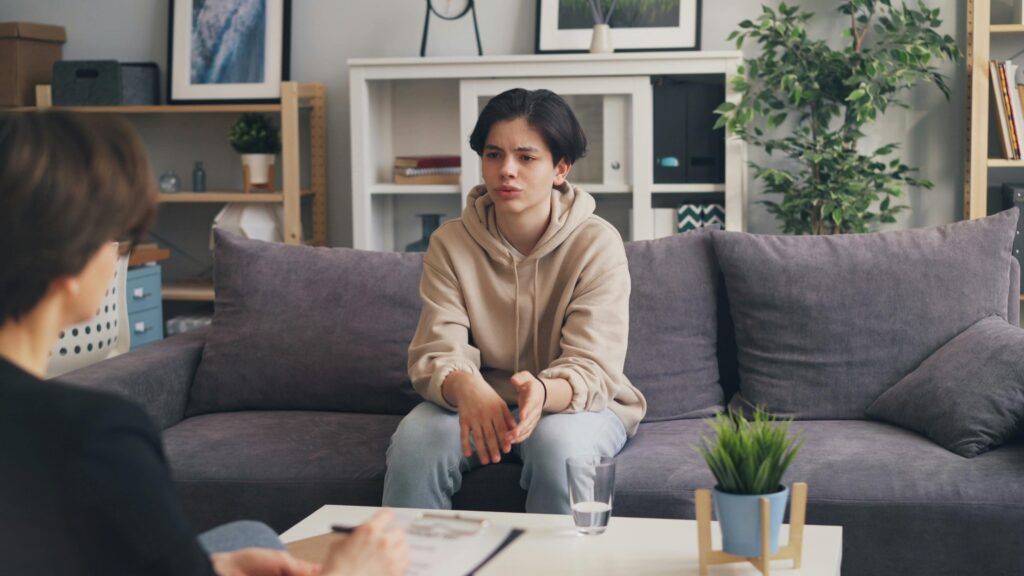Anxiety disorders are among the most common mental health conditions affecting teens. From generalized anxiety to social anxiety, these disorders can impact many areas of a teen’s life, including school, friendships, and daily activities. Unfortunately, many teens may struggle to identify or talk about their anxiety, which can make treatment more challenging.
In this post, we’ll explore the different types of anxiety disorders that teens face, the signs to watch for, and the most effective treatments available. If you’re a parent or a teen looking for guidance on managing anxiety, this guide will help you understand the condition and the steps you can take to improve mental well-being.
Types of Anxiety Disorders in Teens
There are several types of anxiety disorders that teens may experience. Below are some of the most common ones:
1. Generalized Anxiety Disorder (GAD)
Teens with GAD experience persistent, excessive worry about everyday things, even when there is no clear reason for concern. They often have difficulty controlling their anxiety, which can interfere with school, social life, and other activities.
- Symptoms: Constant worry, restlessness, difficulty concentrating, fatigue, muscle tension, irritability, sleep disturbances.
- Treatment: Cognitive Behavioral Therapy (CBT) and medication like SSRIs (Selective Serotonin Reuptake Inhibitors) can help teens manage the persistent anxiety associated with GAD.
2. Social Anxiety Disorder (Social Phobia)
Social anxiety disorder is marked by an intense fear of social situations and a deep worry about being judged or embarrassed in front of others. This can lead to avoidance of social gatherings and even school activities.
- Symptoms: Fear of being scrutinized, blushing, sweating, trembling, heart palpitations in social settings, avoiding social situations altogether.
- Treatment: CBT and exposure therapy are highly effective for social anxiety, where teens gradually face feared situations to build confidence. Social skills training can also be beneficial.
3. Panic Disorder
Panic disorder is characterized by sudden, repeated panic attacks—episodes of intense fear and discomfort that can occur without warning. These attacks can last for several minutes and often include symptoms like chest pain, shortness of breath, dizziness, and a fear of dying.
- Symptoms: Rapid heartbeat, sweating, shaking, shortness of breath, chest pain, dizziness, a feeling of choking, fear of losing control.
- Treatment: Treatment for panic disorder often involves CBT, relaxation techniques, and sometimes medication to help manage symptoms and prevent future attacks.
4. Specific Phobias
Teens with specific phobias experience intense, irrational fear of specific objects or situations, such as heights, spiders, or flying. These phobias can lead to avoidance of situations that trigger fear, which can affect a teen’s daily life.
- Symptoms: Intense fear of a specific object or situation, panic-like symptoms when faced with the trigger, avoidance of places or situations where the trigger may occur.
- Treatment: Exposure therapy, a type of CBT, is effective in treating phobias. It involves gradual, controlled exposure to the feared object or situation to help the teen manage their fear.
How Anxiety Manifests in Teens
Anxiety in teens may look different from anxiety in adults. While some teens may openly express their feelings of worry or fear, others may hide their anxiety or display more subtle signs. Here are some ways anxiety can manifest in teens:
1. Emotional Symptoms
- Excessive worry or fear, often about things that may seem trivial.
- Feeling overwhelmed or “on edge” even in safe situations.
- Difficulty relaxing, restlessness, or irritability.
- Frequent feelings of dread or unease.
2. Physical Symptoms
- Frequent headaches, stomachaches, or other physical complaints that don’t have a clear medical cause.
- Trouble sleeping, including insomnia or nightmares.
- Muscle tension, dizziness, or tightness in the chest.
- Changes in appetite or sudden weight fluctuations.
3. Behavioral Symptoms
- Avoidance of certain situations or places that trigger anxiety.
- Social withdrawal or reluctance to engage in social activities.
- Decline in academic performance or reluctance to attend school.
- Increased reliance on substances or unhealthy coping mechanisms.
If you notice these symptoms in a teen, it’s essential to seek professional help to understand the underlying causes and begin treatment.

Effective Treatments for Teen Anxiety Disorders
There are several approaches to treating anxiety disorders in teens. A combination of therapies and, in some cases, medication can help teens learn to manage their anxiety effectively.
1. Cognitive Behavioral Therapy (CBT)
CBT is one of the most effective treatments for anxiety in teens. It helps teens identify and challenge negative thought patterns and replace them with more realistic, balanced thoughts. CBT also incorporates behavioral strategies, such as exposure therapy, to help teens gradually face their fears and reduce avoidance behaviors.
- Why it works: CBT addresses the root causes of anxiety by teaching teens new ways of thinking and coping, making it a highly effective treatment for a range of anxiety disorders.
2. Medication
In some cases, medication may be prescribed to help manage symptoms of anxiety. Common medications include:
- Selective serotonin reuptake inhibitors (SSRIs), such as fluoxetine or sertraline, which can help regulate mood and reduce anxiety.
- Benzodiazepines for short-term relief, although these are used less frequently due to the potential for dependence.
- Medication is often combined with therapy for the most effective treatment.
3. Mindfulness and Relaxation Techniques
Mindfulness practices, such as meditation, deep breathing exercises, and yoga, can help teens manage anxiety by calming their nervous system and increasing their ability to stay in the present moment. These techniques are often used in combination with other therapeutic approaches.
- Why it works: Mindfulness helps teens gain control over their anxiety by teaching them to focus on the present and reduce stress responses in real-time.
4. Supportive Family and School Environment
A supportive home and school environment can play a critical role in a teen’s ability to manage anxiety. Parents and teachers can work together to create strategies that reduce stress and support the teen’s emotional well-being.
- Why it works: When teens feel supported by those around them, it reduces feelings of isolation and stress, and encourages open communication.
Supporting Your Teen Through Anxiety
Anxiety disorders in teens are treatable, and there are many effective therapies and strategies available to help manage symptoms. If you’re concerned about your teen’s anxiety, early intervention is key. With the right treatment plan, your teen can learn to manage their anxiety and lead a fulfilling life.
If you or your teen are experiencing symptoms of anxiety, don’t hesitate to seek professional support. Our therapists are here to help guide you through the process and provide the tools your teen needs to thrive.
If you think your teen may be struggling with an anxiety disorder, contact Midhues today to schedule an appointment with one of our compassionate therapists.





